Blog Archives
LV Supermeet 2013


Supper Meat before Supermeet
Video editors, filmmakers and consumers of the post-production industry gather at the 12th Annual Supermeet during the week of NAB, the National Association of Broadcasters, to discover the latest in digital post technology. Supermeet took place at its usual location, the Amazon Ballroom, inside the Rio on Tuesday, April 9th, 2012 to roughly a thousand post-fanatic geeks. Hosting Supermeet as usual were Daniel Berube of the Boston branch BOSCPUG and Michael Horton of the Los Angeles branch, LACPUG. All of the post-production groups make up what’s called Creative Pro User Group with CPUGs all over the world.
Before Supermeet, one needs to take advantage of ‘supper meat,’ the appetizers served before the event. Veteran Supermeeters know to get there early. It may not be fast food, but it does go fast.
A last minute surprise addition opened the event with DSLR guru, Vincent Laforet, showing off his new toy, the Movi, a small and light enough device that holds DSLR cameras so they can move effortlessly no matter what obstacles get in its way.
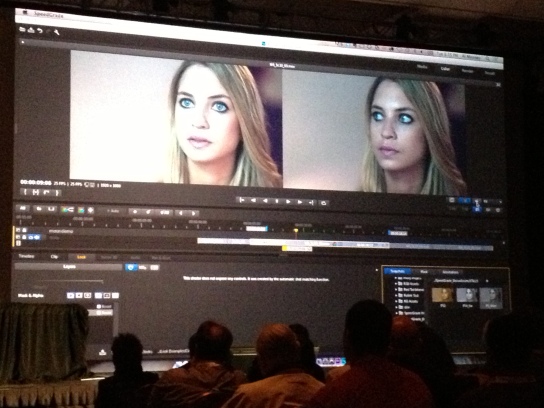
Adobe SpeedGrade
What used to be a main Final Cut Pro soapbox, has become a smorgasbord of NLE systems. Avid showcased its newest features in Media Composer 7 that dropped this week for ONLY $999. Adobe showcased new features in many of its platforms including Premiere Pro, SpeedGrade for color correction and After Effects and its new exciting partnership with Cinema 4-D. And apparently the Coen Brothers plan on editing their next film on Premiere Pro according to Al Mooney, the product manager for Premiere Pro.
Autodesk’s Smoke wowed the tech-heavy crowd. Filmmaker Anthony Brownmoore did a demo on how he used Smoke on his short film, “REP 5091.” Blackmagic Design and Red Giant had demos as well. Strangely enough, there was nothing new to demo for FCP X two years after its announcement and first look at Supermeet in 2010. Maybe they’ll make the cut next year.
In the middle of the event a break from festivities lets the digital gurus roam the sponsors’ booths and network with other digital post geeks.
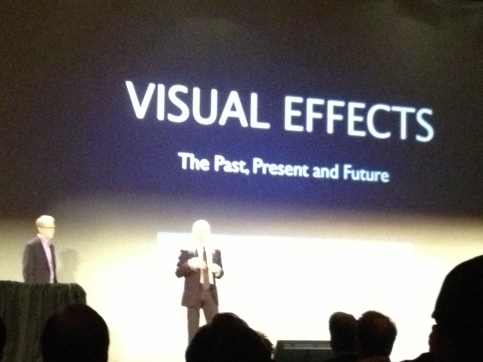
Scott Squires and Scott Ross
The second half of the show was dedicated to the status of the VFX industry. Perhaps you’ve seen profiles on FaceBook and Twitter turned green. Since the Academy Awards, an issue has risen to the surface that’s been simmering for many years. The VFX industry has been suffering more drastically in recent years. We have seen the end of famous VFX studios such as Rhythm & Hues and Digital Domain among many other VFX companies that have gone bankrupt. To put this all in focus, Scott Ross, the Co-Founder and CEO of Digital Domain and Academy nominated VFX supervisor, Scott Squires, addressed the audience with the facts.
Imagine big visual effects oriented movies without the actual VFX. Scott Squires asked the crowd what “Life of Pi” would look like? A boy in a boat talking to a tiger hand puppet is not going to cut it. Ross added, “Claudio Miranda won an Oscar for best cinematography.” Basically, the Oscar winner shot a boy in a boat in a pool surrounded by bluescreen. All the truly amazing work that brought life to the FX heavy film was added later.
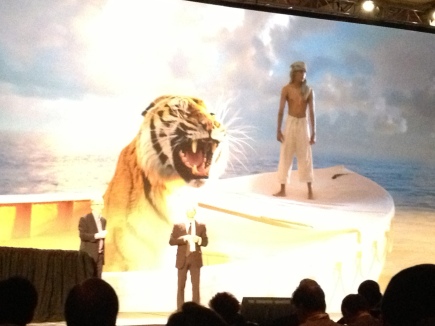
More movies are relying on visual effects to return the movie studios’ investments at the box office. That’s fine for the movie studios, but what about the artists working their butts off 60, 70, 80 hours a week and not seeing an amount of pay to reflect it?
“Most countries have a cap of 60 hours a week. We typically start at 60 and go up from there,” said Scott Ross. He added, “It’s not unusual to work seven days a week.”
VFX companies have at times built VFX studios in Vancouver, Canada so movie studios got tax rebates. And then you have the VFX artists moving their families only to be out of work when the project’s over. What do they do then? Visual effects cost millions of dollars. And there’s no union whatsoever. VFX companies have been ‘under-bidding’ to compete with other VFX companies. And movie studios will start outsourcing VFX more to places like India for even cheaper labor.
 Scott Ross informed the crowd of a meeting to take place in May in Los Angeles with as many of the top VFX companies as he can to discuss the possibilities of a trade association. The industry needs to set regulations and assist the individual VFX artists with better working situations including perhaps points in the films they work on. It was a very serious note and very appropriate to take place at Supermeet. Scott Ross and Scott Squires received a standing ovation from the very empathetic audience.
Scott Ross informed the crowd of a meeting to take place in May in Los Angeles with as many of the top VFX companies as he can to discuss the possibilities of a trade association. The industry needs to set regulations and assist the individual VFX artists with better working situations including perhaps points in the films they work on. It was a very serious note and very appropriate to take place at Supermeet. Scott Ross and Scott Squires received a standing ovation from the very empathetic audience.
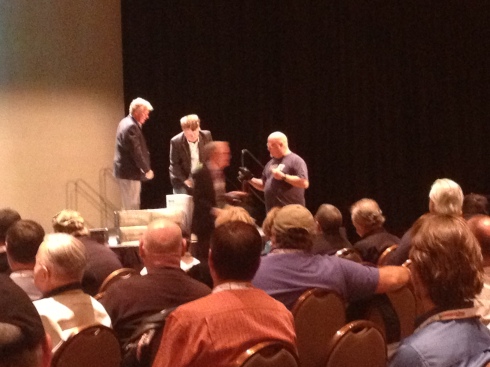 Supermeet always satisfies editors’ exciting curiosity of what’s next in digital post-production and the knowledge of where the industry stands. Things happen and change so often now in this business that one needs to stay informed to survive. If that’s not enough there’s always the giant raffle of amazing prizes at the end of the evening. Grown men with busting guts shout at the top of their lungs, run the entire length of the ballroom when their ticket is called after winning something cool. Supermeet brings out the child in all of us.
Supermeet always satisfies editors’ exciting curiosity of what’s next in digital post-production and the knowledge of where the industry stands. Things happen and change so often now in this business that one needs to stay informed to survive. If that’s not enough there’s always the giant raffle of amazing prizes at the end of the evening. Grown men with busting guts shout at the top of their lungs, run the entire length of the ballroom when their ticket is called after winning something cool. Supermeet brings out the child in all of us.
Additional Article on Visual Effects at Supermeet.
Skip’s Summer School of Photography

Matthew Jordan Smith with model Danica
It’s never too late to go back to school. In today’s economy artists are looking to expand their knowledge and add an additional hat to their never-ending hyphenated areas of expertise. Does one become a ‘jack-of-all-trades’ or master one field? With technology today, it’s becoming easier for the average Joe to be a photographer. Digital cameras are becoming cheaper and more user-friendly. Unless you have a true fan-base and a leads machine after having lived in one place, one town, one state all of your life, it’s very difficult to break in to find your niche as an artist or photographer of any kind. Some creatives are switching from stills to videography and vice versa.
My enrollment into Skip’s Summer School at the Mirage Casino in Las Vegas, NV, was for various reasons. I had attended film school in Los Angeles years ago mainly for writing and directing. I somewhat regret not taking the film camera more seriously. I’ve come to terms that I’m a ‘jack-of-all-trades.’ I got into video editing after my initial exhausted pursuit of writing and directing. My editing career was taking off slowly. When I hit a wall, I left LA for Las Vegas to broaden my horizons. In LA, potential clients wanted editors to know motion graphics and effects. After living in Vegas, I found that potential clients are looking for shooter/editors.
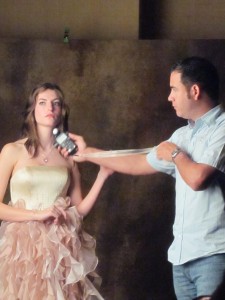
A volunteer gets a light reading
While I am trying to learn both After Effects and Photoshop, I decided I should take my ‘point and click’ to another level. I wanted to improve my picture-taking skills. A year ago, I acquired a Nikon D-40. I’ve only taken it out a bunch of times. And now I’m looking to purchase a Canon DSLR camera to gain potential clients as both a still and video photographer. I also want to shoot my own projects. As much as I don’t really want to be a jack-of-all-trades, you have to be unless you can specialize in one field.
So, in adding an additional hat, I need to learn anything and everything about film, video and photography. Skip’s Summer School, in its 3rd year, was started by Skip Cohen. The event took place from July 31st through August 3rd and was championed by some of the best photographers in the business showcasing their work and sharing their knowledge, tips and experience. These photography gurus included Jules Bianchi and Joy Bianchi Brown, Clay Blackmore, Scott Bourne, Bambi Cantrell, Tony L. Corbell, Bob Davis, Doug Gordon, Kevin Kubota, Tamara Lackey, Bobbi Lane, Matthew Jordan Smith, Roberto Valenzuela and Jerry Ghionis. Vincent Laforet, long-time photographer, turned videographer, gave the closing keynote address.
Vincent Laforet
Vincent Laforet’s photos and videos were stunning! Somehow he got into shooting from helicopters. Then his photos and later videography lead him to being strapped to the scariest and highest places on top on outside ledges of New York’s skyscrapers.
It was soothing for me that Skip’s Summer School came to a wrap with Laforet’s work as he is one of the trendsetter’s for DSLR cameras. He talked about using most of Canon’s cameras. He brought up how a videographer could make an amazing still image from a screen grab of the video. He put the thought out there that a videographer could be hired to go out and shoot video and get stills at the same time without knowing too much about talking photos. They wouldn’t have to shoot stills at all.
Canon – Sidenote
Even before this school started on July 31st, I had taken a seminar the day before sponsored by Canon and local camera store, Casey’s Camera, for a local Las Vegas photography MeetUp group, Photographic Adventures Vegas. The event took place at the Clarion Hotel and was an all-day affair focused on Canon DSLR cameras and PIXMA printers by Canon as well. Lance Folden, a Product Educator, shared his great knowledge about the cameras and what they can do for photographers and filmmakers alike. Stacey Foster, a Sales District Representative, was on hand with an array of Canon cameras on display for attendees to handle and answer questions. Kevin Wagner of iFocus Productions added tips on creating promotional videos.
Canon was scheduled to be at Skip’s Summer School as I could see by the list of companies mentioned at the event, but were nowhere to be found. So, in a sense, I was able to take advantage of something no one else could this past week. It added to my photography education.
Bambi Cantrell

model Danica
As a part of Skip’s Summer School, the local Vegas MeetUp for SmugMug, held a meeting for 125 people on a first-come first served basis. People didn’t have to be enrolled in the school in order to attend. The guest speaker was Bambi Cantrell whom would be speaking at the school too. Cantrell, like all of the other photography gurus, shared what equipment she uses. She gave tips on posing subjects. Another tip was to not over Photoshop your images. Cantrell said photographers should ’embrace road blocks’ as they force ‘abstract ideas.’ Focusing on a subject’s best attributes is another good tip. If a woman has long, sexy legs, feature them. Cantrell stresses that the client needs to see themselves in whatever sample photos shared with them from a portfolio or magazine ads. Her motto is ‘Humility over ability.’
Tamara Lackey
Tamara Lackey mentioned that photographers should meet with a family beforehand to discuss how to proceed if something goes wrong as far as a child’s behavior. If the child acts up during the shoot, try to get them alone and simply talk to them. Lackey told the tale of this one fussy boy who was upset about not having his cranberry muffin that morning. In addition, he was spending his last day of summer school on a photo shoot. After opening up and getting his feelings off his chest, the boy found his smile and was content for the remainder of the shoot. Lackey stressed to photographers to sell clients on the positive things about a photo when there are faults to be found. Perhaps the family members are not all still and leaning on each other perfectly. A boy’s hand placement on his mother’s shoulder shows affection. A little girl’s foot lifting sand up shows action, life, in the moment. And as photographers, look for the positives in your own photos. Learn from your mistakes, but celebrate the good attributes.
Roberto Valenzuela
Roberto Valenzuela will drive you bananas! Well, he often practices with bananas when pre-lighting. He’ll throw a bunch on top of a tripod or stand and look for what shadows it creates. Then he imagines where his subject will be placed. That or he’s just BANANAS! Honestly, his seminar was awe-inspiring! Valenzuela tells the attendees to see things differently and develop an artist’s eye.
“A shadow is an opportunity.”
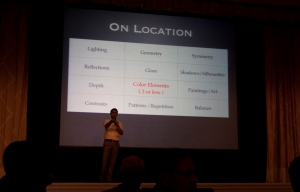
Roberto Valenzuela and his charts
He had charts he developed that help him keep things in mind such as geometry, symmetry, balance, and color in addition to the typical elements; lighting and depth. I overheard other gurus wanting to start implementing Valenzuela’s charts.
That’s the beauty of this school is that everyone is attending to learn from each other including the gurus. The gurus can learn a thing or two from each other. They inspire the attendees and each other.

Roberto gets dust for effect
One of the inspiring things he shared was how he used dust coming up from a car to add an effect in the background of this rural road behind a couple.
He goes on to say that shooting and event is not practice. Photographers need to practice on their own time and be ready on location to be perfect.
‘Perfect practice makes perfect.’
Clay Blackmore
Clay Blackmore’s lecture was more straight forward regarding how to light and pose subjects. He stressed how shoulder placement is the key to great portraits. Blackmore cautions photographers that the use of a flash flattens the face when used head-on. Blackmore tilts his camera to be slightly different. He poses a subject’s face before he sets the lights. He uses triangle shapes to pose people especially in group photos.
‘Application is the key.’
Matthew Jordan Smith
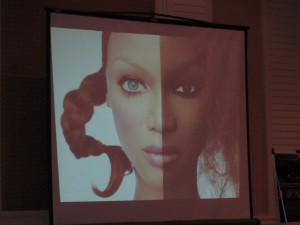
Tyra Banks & Tyra Banks
Matthew Jordan Smith often does a lot of exploring ideas before taking any picture. Smith comes up with very creative ideas and then sets up his subjects accordingly. Smith’s biggest advice is to master one light first. When a photographer feels comfortable using one light then they can move on to an additional light. Smith who’s worked with very famous clients such as Vanessa Williams and Oprah Winfrey does a lot to make his clients feel special before the shoot. He places flowers in their make-up room and plays music to soothe them. He does everything to make his clients feel beautiful. Direct! Don’t pose! Smith suggests not to shoot the same poses everyone else does.
Smith has a conversation with his clients making them feel comfortable and relaxed. The way a photographer speaks or even whispers to his or her client sets a nice tone. In doing so, those life capturing moments will be discovered. Let them let their hair down. He feels that a flash going off in a subject’s face takes them out of the moment.
Make the subject forget they’re sitting for photos especially if they’re dreading it. Smith, knowing ahead of time, told Samuel L. Jackson riddles because he knew he loves them. When Gregory Hines was showing little interest in sitting for pictures Smith told Hines to think about tap dancing in an elevator. And now we all have that visual.
‘Shoot images for yourself no matter what the job is.’
Tony Corbell

Tony Corbell in F.G / Danica model in B.G.
I didn’t have many notes during Tony Corbell’s session. He complimented me on the Who shirt I was wearing. It was a pleasure to watch him shoot various set-ups of that gorgeous model, Danica. Corbell seemed to enjoy shooting her as much as his audience enjoyed watching. Corbell mentioned that when working with ambient light, work to the edge of light.
When Scott Bourne spoke towards the end of the school session he quoted Corbell.
‘I may not be the best photographer, but I may be the nicest photographer.’
Jerry Ghionis
Jerry! Jerry! Jerry! shouted the crowd. Jerry Ghionis is a rock star in this industry as I found out. I kept hearing from people as the week started, ‘Wait until you hear Jerry speak.’ Ghionis is very inspiring. It’s one thing to listen to a photographer talk about his or her craft and then someone truly gets you worked up and inspired to go out and shoot anything.
‘Do you know who you are as an artist?’
Ghionis states the importance of knowing your own identity as it speaks volumes when taking on a shoot or project. He encourages photographers to be different, stand out and experiment. He often uses mirrors and rear-view mirrors. Ghionis says to think outside the box. He’ll actually blur out faces in photos if they lack expression. How brilliant is that? Ghionis says to learn the craft before you go breaking the rules. He uses action in stills to create an effect such as a woman shaking her dress. He’ll use natural smoke as an effect. Ghionis will actually underexpose for a dramatic effect. He’s got all sorts of tricks up his sleeves. Ghionis will ask couples or loved ones to hug each other as if it’s the last time. He says to photograph the subject through the eyes of a loved one. A husband may think ‘She’s the most beautiful woman in the world.’
‘If you want to be a better photographer…be a better person.’
Jules Bianchi and Joy Bianchi Brown
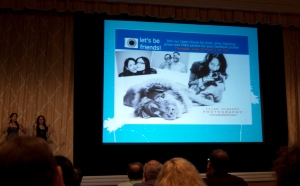
The Binachi Sisters marketing tips
They were two cute fast-talking sisters who had to constantly tell each other to slow down as they spoke. Their session on stage was mostly about how photographers can further their business through networking, likeability and marketing. They had some very good tips. If you want to be in the dog photo business, hang out with dog businesses. Don’t eat alone! Meet a potential client or business contact for lunch. Be generous with your time and share your resources. When at an event introduce yourself and give your name. Don’t just say you’re a photographer. Meet people. You never know where it leads. The sisters say that you should be a connector. Help people out whether it forwards your business or not.
The sisters suggest that photographers can do creative partnering for effective targeted marketing. To do this you can hold free community events, do charitable work and teach workshops. Teaching workshops puts you in a position to be looked upon as an expert. Throw a party! You can offer to shoot free photos for their FaceBook profiles. Then follow-up with hand-written postcards. No one mails postcards anymore. Be different and personal. The Bianchi sisters also had some great tips on sales and closing the deal.
Scott Bourne
Scott Bourne had a lot of similar tips for photographers in his last speech on the last day of school regarding about helping others. Bourne’s main addition is the use of social media, mainly Twitter. Bourne says that just by helping others find what they need may lead to future clients. The example he used was that he read a Twitter post of someone seeking a printer for their wedding photos. Scott knew of a great printer in that area and shared his knowledge with this complete stranger. The hope is that the person will look you up and see your profile. By chance they still need a wedding photographer, they can see that you’re a wedding photographer from your Twitter profile.
I had wanted to sign up for this school months before the event, but didn’t have the money. It’s actually a very good price for what you get back out of it. I signed up a week before the one week school and am so glad I did. It was invaluable. If you know what’s good for you, you should follow Bourne on his Twitter account. (HINT: He gives away cameras. Shh.)
Jerry Ghionis says ‘What’s priceless tomorrow is priceless today.’
